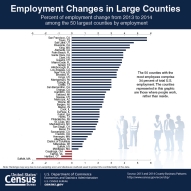San Francisco and Travis, Texas, Lead Nation in Employment Growth among Large Counties, Census Bureau Reports
For Immediate Release: Thursday, April 21, 2016
San Francisco and Travis, Texas, Lead Nation in Employment Growth among Large Counties, Census Bureau Reports
County Business Patterns Now Includes Data by Congressional District
APRIL 21, 2016 — San Francisco, Calif., and Travis, Texas, led the nation in 2014 in annual employment growth among the top 50 U.S. counties with the most employees, according to new U.S. Census Bureau economic statistics released today. Overall, these 50 counties accounted for 34.7 percent of all U.S. employment.
San Francisco’s employment grew 5.7 percent (up 30,931 employees) to 573,297 employees in 2014. The information sector (NAICS 51), up 13.6 percent to 56,684 employees, and the construction sector (NAICS 23), up 10.4 percent to 17,884 employees led growth in that county. Specifically, within these two growing sectors, other information services (NAICS 519), up 27.4 percent to 18,104 employees, and construction of buildings (NAICS 236), up 14.1 percent to 7,425 employees, were the subsectors powering San Francisco’s employment growth.
Three more of the 10 large counties with the highest rate of employment gains were in California. They were Riverside (up 4.4 percent), Alameda (up 4.1 percent) and Santa Clara (up 3.9 percent).
Travis County, Texas, which led in employment with San Francisco, increased 5.7 percent (up 29,289 employees) to 544,038 employees in 2014. Travis also led the largest counties in the rate of growth of business establishments climbing 3.6 percent to 32,217 establishments. Travis County is part of the rapidly growing Austin-Round Rock metro area, whose population topped 2 million people for the first time in 2015, according to recent population estimates.
In Travis, the following sectors drove the overall employment increase: the real estate and rental and leasing sector (NAICS 53) rose 22.3 percent to 13,525 employees; the utilities sector (NAICS 22) rose 16.5 percent to 1,046 employees; and the information sector (NAICS 51) rose 14.6 percent (to 27,437 employees). The accommodation and food services sector (NAICS 72) saw employment rise only 10.0 percent, but gained 6,336 employees.
The respective subsectors powering Travis’ employment growth were rental and leasing (NAICS 532) (up 29.4 percent to 3,162 employees), utilities (NAICS 221) (up 16.5 percent to 1,046 employees), other information services (NAICS 519) (up 32.8 percent to 1,859 employees) and accommodations (NAICS 721), which added 2,658 employees.
Today’s findings are from County Business Patterns: 2014, which provides the only detailed annual information on the number of establishments, employees, and first quarter and annual payroll for nearly 1,200 industries at the national, state, county and congressional district levels.
County Business Patterns debuted 70 years ago and has been published annually for the past 50 years. Today marks the first time congressional district data are included with the annual release.
In the majority — 55.5 percent — of the nation’s congressional districts (based on the 114th Congress) health care and social assistance (NAICS 62) employed more people than any other sector of the economy. Distant runners-up were retail trade (NAICS 44-45), leading as the top employment sector in 15.8 percent of the congressional districts, and manufacturing (NAICS 31-33), leading as the top employment sector for 14.4 percent of the congressional districts.
Among states, North Dakota led in rate of employment growth between 2013 and 2014, climbing 5.3 percent to 360,970, followed by Colorado and Florida at 4.3 percent each. Mining, quarrying and oil and gas extraction (NAICS 21) led North Dakota’s sectors with a 16.4 percent rise in employment to 25,691 employees in 2014.
National Highlights
- Nationally, the number of establishments increased 1.0 percent to 7.6 million in 2014, from 7.5 million in 2013. Employment rose 2.4 percent to 121.1 million employees in 2014, from 118.3 million in 2013.
- Annual payroll was up 5.7 percent, from $5.6 trillion in 2013 to $5.9 trillion in 2014.
- Average payroll per employee climbed 3.2 percent, from $47,534 in 2013 to $49,062 in 2014.
State and County Highlights
- Unsurprisingly, California had more establishments (889,646) and employees (13.8 million) and a larger annual payroll ($797 billion) than any other state in 2014. Texas followed in each measure (557,721 establishments, 9.9 million employees and $501.5 billion in annual payroll). New York ranked third in all three measures: 536,890 establishments, 7.9 million employees and $492.7 billion in annual payroll.
- Los Angeles, Calif., led all counties in the number of establishments (258,982) and employment (3.9 million) followed by Cook, Ill., in both measures (130,833 establishments and 2.3 million employees).
- New York, N.Y. (Manhattan) topped all counties in annual payroll, at $232.4 billion, while ranking third in establishments (105,998) and employees (2.2 million).
- Harris, Texas, ranked fourth in employment at 2.0 million.
- Of the top 50 counties with the highest number of employees, only four saw employment drop: Suffolk, Mass. (down 2.7 percent); Hartford, Conn. (down 0.8 percent); Fairfax, Va. (down 0.5 percent); and Cuyahoga, Ohio (down 0.5 percent).
County Business Patterns excludes business owners who were self-employed, employees of private households, railroad employees, agriculture production workers and most government employees. The statistics are broken down according to employment-size classes (for example, number of establishments with one to four employees) and legal form of organization (for instance, corporations and partnerships). Definitional and coverage differences may affect the direct comparison of economic census data and County Business Patterns data. See the program methodology for more details.
County Business Patterns data are also available for Puerto Rico, Guam, American Samoa, the Commonwealth of Northern Mariana Islands and the U.S. Virgin Islands.
Information on businesses without paid employees will be released as part of the upcoming 2014 Nonemployer Statistics report in May 2016. County Business Patterns data by five-digit ZIP codes will also be released in May 2016.
Tools for Accessing County Business Patterns
County Business Patterns data may be accessed using multiple tools available via the Census Bureau web site, including American FactFinder, QuickFacts, Census Business Builder and My Congressional District.
Other Sources of Local Area Economic Data
The U.S. Census Bureau conducts an economic census every five years and provides a comprehensive and detailed profile of the U.S. economy, covering millions of businesses representing more than 1,000 industries and providing unique portraits of American industries and local communities.
Economic census statistics for 2012 are being released over a two-year period. Statistics at the local level, including information for more than 5,000 communities not available from previous economic censuses, are now available. The local data represent the only source of detailed economic information for more than 15,000 cities, towns and other similar places in the U.S. and provide statistics on measures, for example, revenues, that County Business Patterns does not.
-X-
County Business Patterns defines employment as all full- and part-time employees who were on the payroll during the pay period that includes March 12. Data are obtained from Census Bureau reports and administrative records from other federal agencies. Quality assurance procedures are applied to all phases of collection, processing and tabulation to minimize errors. The data are subject to nonsampling error from miscoding and estimation for missing or misreported data. Values associated with each establishment are slightly modified to protect the confidentiality of each location’s data. Data from NAICS sector 99, industries not classified, are not included in this summary. Further information about methodology and data limitations is available at <//www.census.gov/econ/cbp/methodology.htm>.








